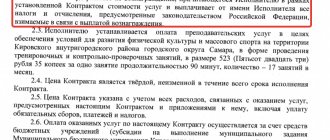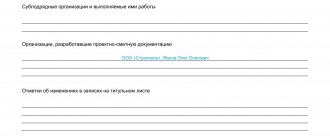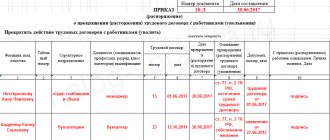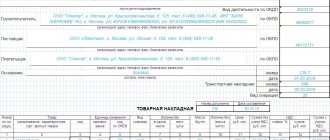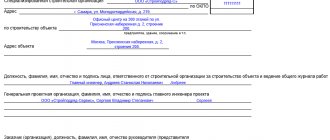When is Form OS-16 needed?
The unified form OS-16, approved by Decree of the State Statistics Committee of the Russian Federation dated January 21, 2003 No. 7, will be needed if, during the process of acceptance, installation, adjustment or testing of the purchased equipment, shortcomings are identified in it that affect the fact that it is recognized as suitable for use as a fixed asset.
Depending on whose fault the defect occurs, representatives of the entire chain of persons/organizations involved in the process of manufacturing and delivering the equipment to the end user may be involved in drawing up a report in form OS-16. The number of copies of the executed act depends on the number of persons who signed it.
The act form approved by Goskomstat is not mandatory for use. The form of a similar act can be developed independently, including by changing the unified form. However, as a rule, the OS-16 form satisfies all the requirements for this document and therefore continues to be in demand.
To learn how you can draw up a report on defects in a fixed asset that require its write-off or repair, read the article “Drawing up a correctly defective report - sample.”
You can find out what entries need to be made in accounting according to Act OS-16 in ConsultantPlus. If you do not have access to this legal system, a full access trial is available for free.
Filling out OS-16 (report of identified equipment defects)
In the header of the document, general data is filled in: name of the customer organization, structural unit, form code according to OKUD, OKPO. Next, fill in the document number and the date of its preparation.
In the main part of the document, first fill in general information about the accepted equipment:
- Number and date of the act according to which the equipment was accepted for installation;
- Place where the equipment is located (exact information: address, building, workshop number);
- Name of the manufacturer, OKPO code;
- Name of the supplier organization, OKPO code;
- Shipper's name, OKPO code;
- Name of the carrier company, OKPO code;
- Name of the installation company, OKPO code.
The following is a list of defects that were found in the equipment. Information about equipment that has been found to have deficiencies is presented in detail in a table of seven columns containing the following information:
- Equipment identification;
- Passport number or equipment marking;
- Brand of equipment;
- Project organization;
- Date when the equipment was manufactured;
- Date the equipment arrived;
- Defects that were found in the equipment.
Information for each piece of equipment is recorded separately in the table. Under the tabular part, the work that needs to be done to eliminate the identified defects, the performing companies that will carry out the necessary work, and the deadlines are indicated in detail.
The act is filled out by a representative of the organization installing the equipment. The document must be completed on the day the defects were discovered.
Act OS-16 is signed by a representative of the customer organization and a representative of the installation organization, indicating the position and a transcript of the signature. Further space is provided for printing and indicating the date. Further, a place is provided to indicate the signature of a representative of the manufacturer, indicating the position, transcript of the signature, and date of signature.
Each representative of the organizations that signed the document receives a copy of the act. One copy must be handed over to the installation organization, the second copy is intended for the customer, and the third for the equipment manufacturer. If necessary, additional copies can be compiled.
How to fill out Form OS-16
The front side of the OS-16 form reflects the following data:
- about the owner of the equipment;
- location of the equipment;
- details of the document being drawn up and documents related to operations performed with the equipment;
- persons involved in the manufacture, delivery and installation of equipment;
- identified defects.
The reverse side contains a conclusion about who and what measures should be taken to bring the equipment into normal operating condition. The conclusion is signed by representatives of all interested parties. The Goskomstat form contains instructions for affixing the seal of the customer and the installation organization.
About the nuances of submitting VAT related to equipment, read the material “How to claim VAT on fixed assets or equipment for deduction?” .
Filling out the fields of the standard form
The appearance of the OS-16 form does not differ from other similar accounting forms.
The first sheet of the report on identified defects in the upper part contains information about the organization that ordered the equipment and its location in the structural unit (store, warehouse). In the columns on the right, enter OKPO and OKUD of the customer.
The form is assigned a serial number with the date of its preparation. After the name, on the right side, the details of the act (number, date) are indicated on the basis of which the equipment was accepted (transfer to the installation, acceptance of fixed assets). Then - the names of the companies responsible for the production, delivery, shipment and installation of equipment, as well as OKPO codes for each enterprise.
Then you need to indicate exactly when defects were discovered in the devices (during testing, installation). Defect information is given below:
- device name;
- number or designation of the technical passport;
- Type of equipment;
- date of manufacture of the equipment and its receipt;
- description of the defect for each piece of equipment.
The table should also include the names of the companies that developed each type of device. The reverse side of the Defect Statement should recommend the actions required to correct the hardware defect. All activities are described in detail. Signatures on the completed pages of the OS-16 form are made by representatives of the customer, manufacturer and installation organization.
In the process of certifying the form of the act, the enterprise determines the conditions for carrying out repair work, and the seal of the enterprise is affixed to the form signed by the marriage. If it is necessary to replace damaged equipment with new equipment, the parties also agree on the exact date for replacement of the facility, transportation and installation.
The positive side of using form OS-16 is that there is no need to appoint a special commission. The act comes into force from the day it is signed by all parties.
You can download the agreed form of Act OS-16, as well as its completed sample.
Where to find the OS-16 form
Form OS-16 can be downloaded from our website:
On our website you can also download a completed sample of the OS-16 form and use it as a basis for drawing up your own documents.
You can find more complete information on the topic in ConsultantPlus. Free trial access to the system for 2 days.
Download the unified form OS-16 (defective act). Sample filling
Below you can use the link to fill out the form.
Download sample forms for accounting for fixed assets at an enterprise: Form OS-1. Filling out the act of acceptance and transfer of fixed assetsForm OS-1a. Filling out the building acceptance certificateForm OS-2. Invoice for internal movement of fixed assets Form OS-3. Certificate of acceptance and delivery of fixed assets after repair Form OS-4. We fill out the act on write-off of fixed assetsForm OS-4A. Vehicle write-off certificate Form OS-6. Inventory cardForm OS-6B. Inventory bookForm OS-14. Certificate of acceptance and transfer of equipmentForm OS-15. Certificate of acceptance and transfer of equipment for installation Order for write-off of fixed assets Disposal of fixed assets (postings, examples) Accounting for lease of fixed assets (postings, examples) Accounting for receipt of fixed assets (documents, postings) Methods for calculating depreciation of fixed assets
Procedure for filling out the act
Form OS-16 is filled out on both sides by a commission, which usually includes representatives of the manufacturer, the customer and the company that installed and commissioned the equipment.
Sample of the first page of the act.
The appearance of the document is no different from other accounting forms.
Registration begins at the top of the form, where the following is indicated:
- the name of the organization that purchased this equipment, with the actual address of its installation;
- the department that installed it (specific workshop);
- documents according to which the equipment was installed, adjusted or tested;
- manufacturing plant, its OKPO;
- details of the supplier's organization;
- it must be indicated at what stage the defects or damage were discovered;
- if the installation was carried out by a third-party company, then its details must be indicated.
Now you can proceed directly to filling out the table. Here you can find complete information about the faulty equipment:
- Its type, brand, serial number;
- Date of admission to the enterprise;
- Detected faults, their number, units of measurement.
Sample of filling out the OS-16 form.
The second page of the form reflects the results, that is, the commission’s conclusion about the malfunctions, the culprits (if any), as well as specific solutions are indicated here.
Important! Damage repair work is scheduled in as much detail as possible.
Representatives of all organizations put their signatures at the bottom of the page.
Sample of the second side of the form.
The number of copies of documents is equal to the number of participating parties, that is, the number of organizations that signed the act. But in some cases, an additional copy of the document is sent to the design organization at its request (if for some reason they were unable to take part in the work of the commission).
Post Views: 267
We hand over the equipment for installation and prepare documents
Active account 08 “Investments in non-current assets” is intended for accounting of equipment installation. It is here that not only the cost of the installed equipment itself is taken into account, but also the costs associated with installation are collected. This means that when the equipment itself is transferred for installation, the accounting entry will be as follows (Order of the Ministry of Finance dated October 31, 2000 No. 94n):
Debit account 08 - Credit account 07
And when reflecting wiring installation work, the following may be:
Debit of account 08 – Credit of accounts 10 “Materials”, 60 “Settlements with suppliers and contractors”, 70 “Settlements with personnel for wages”, 69 “Settlements for social insurance and security”, 71 “Settlements with accountable persons”, etc.
To formalize the transfer of equipment for installation, Resolution of the State Statistics Committee dated January 21, 2003 No. 7 approved the form of the Certificate of Acceptance and Transfer of Equipment for Installation (form No. OS-15). This form, however, like the Act on Form No. OS-14, is not mandatory for use (Information of the Ministry of Finance No. PZ-10/2012). The organization itself decides whether to use these forms for these purposes or develop independent forms. It is only important that the primary source used is approved in the organization’s Accounting Policy for accounting purposes.
If an organization decides to use form No. OS-15, some features of its completion can be found in the Instructions approved in Resolution of the State Statistics Committee of January 21, 2003 No. 7. Thus, the act in form No. OS-15 is drawn up in at least 2 copies. At the same time, when installing using a self-employed method, i.e. using one’s own resources, an act is drawn up at the time of the actual transfer of the equipment for installation.
In what cases is it compiled?
When equipment arrives at the warehouse, an acceptance certificate is drawn up in form OS-14. A defect report can be drawn up already at this stage if the commission identifies any defects during acceptance.
When the external features of the fixed asset correspond to the declared documentation, the equipment is transferred for subsequent installation on the basis of the OS-15 act. During equipment assembly, testing and commissioning, the object may also turn out to be unsuitable for use. In this case, a report on identified defects is drawn up in form OS-16.
Depending on the culprit of the origin of the defect in the fixed asset, representatives of each company that participated in the production of the equipment and its delivery to the final destination may be involved in drawing up the report. Along with this, it is necessary to note the fact that the form can later be adjusted by the user himself.
The number of printed copies of the OS-16 act directly depends on the number of officials who signed it.
What form should I use to draw up a defective document?
The form for describing identified defects OS-16 was approved by Resolution of the State Statistics Committee No. 7 of January 21, 2003.
The use of an exclusively unified form is not specified by law.
Enterprises can develop their own form, but the document filled out according to the OS-16 form contains all the necessary fields to fill out.
The unified form of the OS-16 act is more in demand than any other form.
